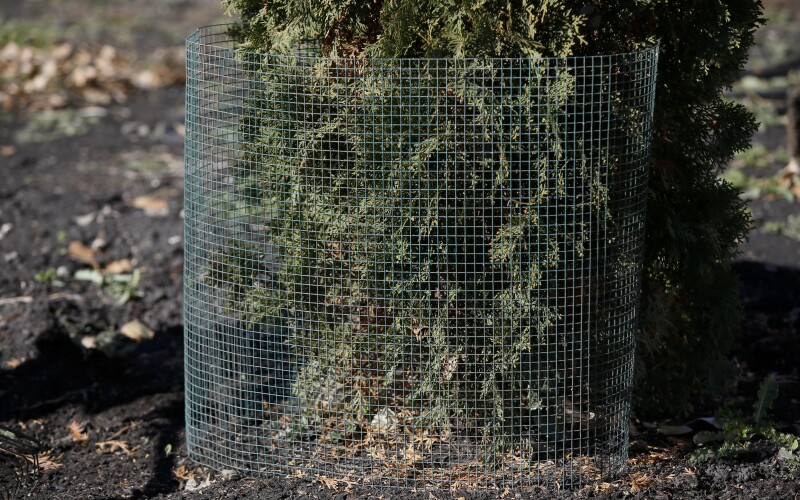Lifestyle
Final Checklist: Preparing Your Yard and Garden for Winter

As temperatures drop and the first signs of winter approach, homeowners are urged to prepare their yards and gardens for the colder months. This seasonal transition requires attention to various factors, especially as the growing season comes to an end. Below is a comprehensive checklist for ensuring your outdoor spaces are ready for winter.
Protecting Your Plants from Wildlife
With the arrival of colder weather, rabbits and voles pose significant threats to gardens. These animals can cause substantial damage to fruit trees and shrubs when other food sources are scarce. Vulnerable plants include apple, plum, and pear trees, along with shrubs like rose, arborvitae, and hydrangea.
Fencing remains the most effective deterrent. Homeowners can also consider using repellents such as Liquid Fence and Plantskydd, which have proven successful in deterring these pests. To establish protective fencing before the ground freezes, it is advisable to secure stakes or posts in place as early as November.
To safeguard delicate plants, apply protective mulch after the soil begins to freeze. A layer of leaves, straw, or shredded wood, measuring between 12 to 24 inches thick, can insulate plants from extreme cold, particularly if snow cover is absent.
Preparing Your Garden for the Cold
As winter approaches, it is crucial to prepare garden tools and equipment. Disconnect water hoses from outdoor spigots and drain watering devices to avoid breakage due to freezing temperatures. Store liquid herbicides and insecticides in a location where they will not freeze, as most are negatively affected by low temperatures. If transferring chemicals indoors, consider sealing containers in tightly closed plastic bags to avoid unpleasant odors.
To reduce disease potential for the following spring, remove dead plants from outdoor containers. Voles, which can damage lawns and trees, may require trapping or repellent methods for effective control. The use of traps baited with peanut butter or placing poisoned baits in PVC pipe can provide protection while keeping baits out of reach of pets.
For lawns, a final mowing is recommended when grass begins to turn brown. Cutting the grass to a height of approximately 2 inches helps prepare it for winter. Additionally, covering the trunks of thin-barked trees can prevent sunscald damage, particularly for species like fruit trees and maples.
As the growing season wraps up, dispose of fallen apples and cut back the tops of perennials such as iris, hosta, and peonies. This practice can help control disease and prepare plants for the next cycle.
Watering is also essential; ensure evergreens and newly planted trees receive a good soak if rainfall has been inadequate. Any unplanted trees, shrubs, bulbs, or perennials should be installed before the ground freezes to facilitate their transition into winter.
Taking the time to properly care for garden tools at the end of the season can extend their lifespan. Clean off excess soil and apply a light coat of oil to prevent rust. Wooden handles can benefit from a treatment of linseed oil mixed with turpentine.
Finally, mark the locations of young perennials and bulbs with stakes or labels before the ground becomes too hard to work. It is advisable to document which flower and vegetable cultivars performed well during the summer while the memories are still fresh.
By following this checklist, homeowners can ensure their gardens are secure and well-prepared for the winter, setting the stage for a successful growing season come spring.
-

 Science3 weeks ago
Science3 weeks agoIROS 2025 to Showcase Cutting-Edge Robotics Innovations in China
-

 World3 weeks ago
World3 weeks agoBravo Company Veterans Honored with Bronze Medals After 56 Years
-

 Politics2 weeks ago
Politics2 weeks agoJudge Considers Dismissal of Chelsea Housing Case Citing AI Flaws
-

 Lifestyle3 weeks ago
Lifestyle3 weeks agoStone Island’s Logo Worn by Extremists Sparks Brand Dilemma
-

 Health3 weeks ago
Health3 weeks agoStartup Liberate Bio Secures $31 Million for Next-Gen Therapies
-

 Top Stories3 weeks ago
Top Stories3 weeks agoIndonesia Suspends 27,000 Bank Accounts in Online Gambling Crackdown
-

 Health3 weeks ago
Health3 weeks agoTop Hyaluronic Acid Serums for Radiant Skin in 2025
-

 Sports3 weeks ago
Sports3 weeks agoMel Kiper Jr. Reveals Top 25 Prospects for 2026 NFL Draft
-

 World3 weeks ago
World3 weeks agoHoneywell Predicts Record Demand for Business Jets Over Next Decade
-

 Lifestyle3 weeks ago
Lifestyle3 weeks agoMary Morgan Jackson Crowned Little Miss National Peanut Festival 2025
-

 Sports3 weeks ago
Sports3 weeks agoYamamoto’s Mastery Leads Dodgers to 5-1 Victory in NLCS Game 2
-

 Science3 weeks ago
Science3 weeks agoArizona State University Transforms Programming Education Approach









